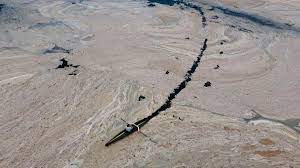Today Current Affairs: 22nd September 2021 for UPSC IAS exams, State PSC exams, SSC CGL, State SSC, RRB, Railways, Banking Exam & IBPS, etc
Table of Contents
National Snakebite Awareness Summit:

National Snakebite Awareness Summit was recently organised in virtual mode by the Integrated Health and Wellbeing Council, New Delhi.
- The summit was held on the eve of the International Snakebite Awareness Day, observed on 19 September every year.
- India is registering an alarming number of deaths due to snakebite. Most of the deaths are preventable with greater awareness and accessible healthcare.
- There is no mechanism of management in the peripheral system to treat snakebites – doctors and paramedical staff need to learn snakebite management but there are no modules.
- Establishment of a dialysis centre attached to the PHCs to offer immediate treatment to those with renal failure due to snakebite.
- Region-specific treatment protocols to treat snakebite victims and to administer the anti-venom injection, when required.
- Besides, we need to include tribal healers who have the knowledge of traditional medicine and medicinal plants.
- Snakebite should be a notifiable disease and industry can bring in easy solutions but we need help from policymakers in doing that.
- Need more localized surveys as preventing snakebite will bring equity – most affected people include children working with parents on fields, villagers and tribals.
What Is A Sea Snot?

The sea snot that dominated the landlocked Marmara Sea earlier this year is nowhere to be seen on the surface nowadays, but its fallout appears to be bigger than experts initially hoped.
Impact of sea snot:
- Overall, 60% of species have already disappeared.
- The layers have sunk and are beginning to decompose.
- The decomposition consumes oxygen in the water, which in turn promotes the formation of new marine mucilage.
- In October, the conditions will be particularly favorable for a new spread. Therefore, the sludge may be visible on the surface again in November.
- The slime could also spread to the Black Sea and the Aegean and may cause a regional ecological crisis.
Turkey’s Sea of Marmara, that connects the Black Sea to the Aegean Sea, has witnessed the largest outbreak of ‘sea snot’. The sludge has also been spotted in the adjoining Black and Aegean seas.
About Sea snot:
- It is a slimy layer of grey or green sludge, which can cause considerable damage to the marine ecosystem.
- It is formed when algae are overloaded with nutrients.
- A ‘sea snot’ outbreak was first recorded in the country in 2007. Back then, it was also spotted in the Aegean Sea near Greece.
- Overloading of nutrients happens because of warm weather caused by global warming, water pollution, uncontrolled dumping of household and industrial waste into the seas etc.
- Turkey has decided to declare the entire Sea of Marmara as a protected area.
- Steps are being taken to reduce pollution and improve treatment of waste water from coastal cities and ships.
- A disaster management plan is being prepared.
NCRB Data On Offences Against State:

As per the latest data released by NCRB:
- Manipur, Assam and Uttar Pradesh recorded the highest number of cases under ‘Offences against State’ in 2020.
- However, there was a decline in the overall number of cases registered — 5,613 cases (26.7 per cent) in 2020 as against 7,656 cases in 2019.
- Of the 5,613 cases, 4,524 cases (80.6 per cent) were registered under the Prevention of Damage to Public Property Act, followed by 796 cases (14.2 per cent) under UAPA.
- Meanwhile, Manipur, Assam, Karnataka and Uttar Pradesh recorded the highest number of sedition cases in 2020.
- Among the Union Territories, Delhi recorded 5 sedition cases.
- ‘Offences against State’ includes cases booked under sedition, Unlawful Activities Prevention Act (UAPA), Official Secrets Act, damage to public property, and imputation, assertions prejudicial to national integration.
Grey Market:

There were few articles recently mentioning about Grey Market. Traders are interested in grey market stocks because it can be a way of taking advantage of movements in the company’s share price before it has actually listed.
- Also, any activity is usually taken as an indicator for the direction the stock price will take once it has listed. The pre-market price can be used to gauge the demand for the shares.
What is an IPO grey market?
- Generally, when companies wish to raise funds to fuel their growth, they sell a part of their stock on the stock market. This process is called an initial public offering, or IPO.
- But, an IPO grey market is an unofficial market where IPO shares or applications are bought and sold before they become available for trading on the stock market.
- It is also termed a parallel market or an over-the-counter market.
- Since it’s unofficial, inevitably, there are no regulations that govern it. The Securities and Exchange Board of India (SEBI), stock exchanges, and brokers have no part to play in it. These transactions are undertaken in cash on a one-on-one basis.
- For companies, the grey market is a great way to know how the demand for their shares is and how the company’s shares might perform once it is listed.
- Apart from that, an IPO grey market could be used to gauge how the company’s stock will perform once it is listed.
- The IPO grey market is an unofficial market that performs outside SEBI’s purview.
- Thus, there are no guarantees. All transactions are undertaken on the basis of trust and carry counterparty risk.
Saudi Arabia Foreign Minister’s Visit:

The Indian External Affairs Minister met the Foreign Minister of the Kingdom of Saudi Arabia.
About the Meeting:
- Cooperation in Multilateral Forums: Discussed bilateral cooperation in multilateral forums such as the United Nations, G-20 and Gulf Cooperation Council (GCC).
- India is not a member of GCC.
- Implementation of the Strategic Partnership Council Agreement (signed in 2019):
- India-Saudi Strategic Partnership Council was formed to coordinate on strategically important issues.
- The council will be headed by the Prime Minister and Crown Prince Mo hammed and will meet every two years.
- India is the fourth country with which Saudi Arabia has formed such a strategic partnership, after the UK, France and China.
- Saudi Arabia has been a strategic partner of India since the signing of the Riyadh Declaration in 2010.
- Focus on the Developments in Afghanistan and Other Regional Issues: Saudi Arabia, along with Pakistan and the UAE, were the key backers of the Taliban regime that ruled Kabul from 1996 till 2001 when they were ousted by US-led international troops.
- Strengthening Partnership: Discussed further steps to strengthen their partnership in trade, investment, energy, defence, security, culture, consular issues, health care, and human resources.
Forest Rights Act:

The Jammu and Kashmir government has decided to implement the Forest Rights Act (FRA), 2006, which will elevate the socio-economic status of a sizable section of the 14-lakh-strong population of tribals and nomadic communities.
- FRA enacted in 2006 recognises the rights of forest-dwelling tribal communities and other traditional forest dwellers to forest resources on which these communities were dependent for a variety of needs, including livelihood, habitation and other sociocultural needs.
- It recognizes and vest the forest rights and occupation in Forest land in Forest Dwelling Scheduled Tribes (FDST) and Other Traditional Forest Dwellers (OTFD) who have been residing in such forests for generations.
- It strengthens the conservation regime of the forests while ensuring livelihood and food security of the FDST and OTFD.
- The Gram Sabha is the authority to initiate the process for determining the nature and extent of Individual Forest Rights (IFR) or Community
- Forest Rights (CFR) or both that may be given to FDST and OTFD.
Rights Under the Forest Rights Act:
- Title rights: It gives FDST and OTFD the right to ownership to land farmed by tribals or forest dwellers subject to a maximum of 4 hectares.
Ownership is only for land that is actually being cultivated by the concerned family and no new lands will be granted. - Use rights: The rights of the dwellers extend to extracting Minor Forest Produce, grazing areas etc.
- Relief and development rights: To rehabilitate in case of illegal eviction or forced displacement and to basic amenities, subject to restrictions for forest protection.
- Forest management rights: It includes the right to protect, regenerate or conserve or manage any community forest resource which they have been traditionally protecting and conserving for sustainable use.
Mount Kun:

Raksha Mantri Shri Rajnath Singh flagged-in, in New Delhi on September 20, 2021, a team of National Institute of Mountaineering & Allied Sports (NIMAS) Dirang, Arunachal Pradesh, which completed a mountaineering expedition to Mount Kun (7,077 metres).
- The team, led by Institute Director Colonel Sarfraz Singh, conducted the expedition to the Nun-Kun Mountain Massif which is the highest feature of Zanskar ranges located in Kargil.
- The Nun Kun mountain massif consists of a pair of Himalayan peaks: Nun, 7,135 m (23,409 ft) and its neighbor peak Kun Peak, 7,077 m (23,218 ft).
- Nun is one of the highest peaks in the part of the Himalayan range lying on the Indian side of the Line of Control in Ladakh. The massif is located near Sankoo in the Suru valley, Kargil district
- The Nun Kun massif is bounded to the north by the Suru valley and the Zanskar range. To the South lies the Kishtwar National Park and the Krash Nai river.
- Kun Peak is located north of Nun Peak and is separated from it by a snowy plateau.
Plant Discoveries 2020:

The Botanical Survey of India, in its new publication Plant Discoveries 2020 has added 267 new taxa/ species to the country’s flora.
- The 267 new discoveries include 119 angiosperms; 3 pteridophytes; 5 bryophytes, 44 lichens; 57 fungi, 21 algae and 18 microbes.
- In 2020, 202 new plant species were discovered across the country and 65 new records were added.
- With these new discoveries the latest estimate of plant diversity in India stands at 54,733 taxa including 21,849 angiosperms, 82 gymnosperms, 1,310 pteridophytes, 2,791 bryophytes, 2,961 lichens, 15,504 fungi, 8,979 algae and 1,257 microbes.
- Among the new discoveries this year, nine new species of balsam (Impatiens) and one species of wild banana (Musa pradhanii) were discovered from Darjeeling and one species each of wild jamun (Syzygium anamalaianum) from Coimbatore in Tamil Nadu and fern (Selaginella odishana) were recorded from Kandhamal in Odisha.
- There are 14 new macro and 31 new micro fungi species recorded from various parts of India.
- An assessment of the geographical distribution of these newly discovered plants reveals that 22% of the discoveries were made from the Western Ghats followed by the Western Himalayas (15%), the Eastern Himalayas (14%) and the Northeast ranges (12%).
- The west coast contributed 10% while the east coast contributed (9%) in total discoveries; the Eastern Ghats and south Deccan contribute 4% each while the central highland and north Deccan added 3% each.
Exercise ‘Samudra Shakti’:

Indian Naval Ships Shivalik and Kadmatt arrived at Jakarta, Indonesia on 18 September 2021 to participate in the 3rd edition of Bilateral Exercise ‘Samudra Shakti’ with the Indonesian Navy scheduled off the approaches to Sunda Strait from 20 Sep to 22 September, 2021.
- The exercise aims to strengthen the bilateral relationship, enhance mutual understanding and interoperability in maritime operations between the two navies.
- The exercise will also provide an appropriate platform to share best practices and develop a common understanding of Maritime Security Operations.
- In pursuance of India’s Act East Policy, Exercise ‘Samudra Shakti’ was conceived in 2018 as a bilateral IN-IDN exercise.
- The exercise has matured in complexity over the last two editions and will involve conduct of complex maritime operations including Military Interdiction Operations (MIO), Cross Deck Landings, Air Defence serials, Practice Weapon Firings, Replenishment Approaches and Tactical Manoeuvres.
3rd State Food Safety Index:

Union Minister for Health and Family Welfare Mansukh Mandaviya released Food Safety and Standards Authority of India (FSSAI)’s 3rd State Food Safety Index (SFSI) to measure the performance of States across five parameters of food safety.
- The Union Minister for Health and Family Welfare felicitated nine leading States/UTs based on the ranking for the year 2020-21 for their impressive performance.
- This year, among the larger states, Gujarat was the top ranking state, followed by Kerala and Tamil Nadu.
- Among the smaller states, Goa stood first followed by Meghalaya and Manipur.
- Among UTs, Jammu & Kashmir, Andaman & Nicobar Islands and New Delhi secured top ranks.
- He also flagged off 19 Mobile Food Testing Vans (Food Safety on Wheels) to supplement the food safety ecosystem across the country taking the total number of such mobile testing vans to 109.
Trans Fat:
- The Union Minister released the results of PAN-India survey for identifying the presence of industrially produced trans fatty acid content in the selected foods.
- Samples of various packaged food items under six pre-defined food categories were collected from 419 cities/districts across 34 States/UTs.
- Overall, only 84 samples, i.e. 1.34%, have more than 3% industrially produced trans fats from the total of 6245 samples; India is on the right track of becoming industrial trans fats free in the 75th year of India’s independence.
Global Innovation Index 2021:

India has climbed 2 spots and has been ranked 46th by the World Intellectual Property Organization (WIPO) in the Global Innovation Index 2021 rankings.
- India has been on a rising trajectory, over the past several years in the Global Innovation Index (GII), from a rank of 81 in 2015 to 46 in 2021.
- The GII report is published by WIPO in partnership with the Portulans Institute, with support of corporate network partners, such as the Confederation of Indian Industry, Brazilian National Confederation of Industry, Ecopetrol Group (Colombia), and the Turkish Exporters Assembly.
- Lauding India’s efforts, the GII report said that selected middle-income economies are changing the innovation landscape, starting with China; Turkey, Vietnam, India, and the Philippines now pulling their weight.
National Florence Nightingale Award 2020:

Deputy Director General of Military Nursing Service (MNS) Brig S V Saraswati has been bestowed with the National Florence Nightingale Award 2020
- National Florence Nightingale Award is the highest national distinction a nurse can achieve for selfless devotion and exceptional professionalism.
- President Shri Ram Nath Kovind conferred the award for her immense contribution to the MNS as nurse administrator.
Vishnuonyx:

Between 12.5 million and 14 million years ago, members of a genus of otters called Vishnuonyx lived in the major rivers of southern Asia.
- Fossils of these now extinct otters were first discovered in sediments found in the foothills of the Himalayas. Now, a newly found fossil indicates it had travelled as far as Germany. The discovery has been described in the Journal of Vertebrate Paleontology.
- Researchers from the Universities of Tübingen and Zaragoza have discovered the fossil of a previously unknown species, which they have named Vishnuonyx neptuni, meaning ‘Neptune’s Vishnu’.
- The species was discovered from a 11.4-million-year-old strata in the area of Hammerschmiede, which is a fossil site in Bavaria, Germany that has been studied for about 50 years.
- This is the first discovery of any member of the Vishnuonyx genus in Europe; it is also its most northern and western record till date.
- Vishnuonyx were mid-sized predators that weighed, on average, 10-15 kg.
- Before this, the genus was known only in Asia and Africa (recent findings show that Vishnuonyx reached East Africa about 12 million years ago.




